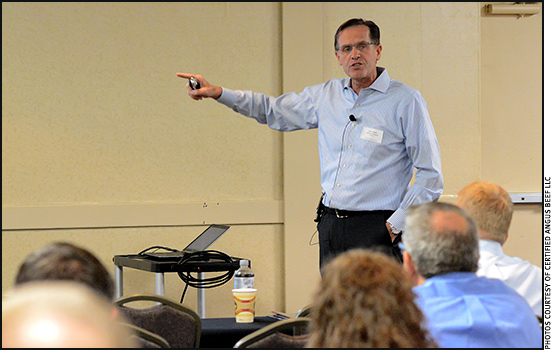
Ag Outlook: Not So Good, Not All Bad
Basse predicts price plateaus for most commodities.
“Who is going to flinch first?”
Dan Basse, president of AgResource Co., said that’s the main question he and his team ponder when looking at this “plateau” phase in the ag markets.

“If you want to get bullish in American agriculture, the thing that you want to see is a drop in the U.S. dollar. The problem is, the United States is the reserve currency, almost by default, these days,” said Dan Basse, president of AgResource Co.
“Is it your neighbor that’s going to cut back? Is it you?” the analyst asked, as he addressed cattle feeders and allied industry representatives at the Feeding Quality Forum in August.
The world has added 179 million crop acres during the last decade, and livestock production is currently in a “dynamic expansionary phase,” Basse said. Ethanol demand has matured and a strong U.S. dollar hurts global competition.
“If you want to get bullish in American agriculture, the thing that you want to see is a drop in the U.S. dollar,” he said. “The problem is, the United States is the reserve currency, almost by default, these days.”
Yet even with more production from predicted record yields and stocks-to-use ratios, “the story for grains is not all that bad,” he said.
South American drought hurt that region’s corn yields before rainfall at 250% to 400% of normal hampered soybean production. That will bode well for U.S. exports.
“I worry that we don’t have enough capacity,” Basse said, noting the United States can move about 600 million bushels (bu.) combined of corn, soybeans and wheat each month through its current infrastructure. “There are going to be months that we don’t have enough capacity to export everything the world wants.”
That creates a strong signal to cattle feeders, he said. “You’ve got to be prepared for basis appreciation because there’s going to be a big sucking sound down at the Gulf. That sucking sound is the export demand sopping up bushels, and you can only hope that farmers will be willing to sell them.”
Basse suggested corn will average around $3.40 per bu., and if it dips below $3.25, feeders “want to be a long-term buyer.” AgResource predicts average soybean prices around $9.43 per bu., with lows around $9.25.
“We’ve lived through $3 corn and $1.10 or $1.20 cattle before. That’s not something that’s new,” he said. “What’s new is that our cost structure is out of whack.”
Input prices are still relatively high, and farm incomes have decreased the last four years, down to the lowest levels since 2001.
“Low prices don’t mean the same for everybody,” Basse said. Places like Argentina and Russia have weak currency, which bolsters their position in the marketplace.
“In the ag world, there are two different things that cause us to have anxiety,” Basse said. “No. 1 is weather, which is always changeable and difficult. No. 2 is policy.”
Case study
He explained, using Argentina as a case study. When Mauricio Macri was elected in December, his goal was to eliminate export taxes on most agricultural products.
Argentinian farmers were paying taxes in the 27% to 35% range: “The next day, you don’t have to pay a tax at all — how are you going to feel?”
Farmers there are making $400 per acre more this year compared to last.
That’s a big contrast to the United States.
“This is the first year you went to the fields and planted corn and soybeans looking at sizable losses,” Basse said, noting his team estimates a $70-per-acre deficit. “Policy has to get involved here for the grain farmer to stop farming.”
There is tempered optimism in the beef business, however.
Cow-calf margins are down, but Basse still predicts a profit of $100 per head out into 2017.
“When I look at annual feeding margins, it’s getting better, but, boy, it’s been a tough road,” he said. “The good news is that per capita meat consumption in the United States is rising again. We’ve seen price starting to stimulate more consumption of beef.”
Basse said the futures in August were undervalued by about $10.
“We are not advocating strong hedging, unless you have the margin in the cattle market as we sit,” he said. He predicted a first-quarter cash cattle price in the “mid-120s,” noting, “It’s not a big rally, but it’s something.”
Looking ahead to global factors and maintaining a competitive edge, Basse said producers need to keep improving their cattle, because the rest of the world is on it.
“If I go give this speech to Rockhampton in Australia, they’re feeding more grain than they’ve ever seen before. Argentinians are putting in feedlots, and they’re going to be plowing up their Pampas where their cattle have been grazing,” he said. “We'll see the shift, more grain being fed and more focus on marbling and quality than before.”
The title “grain-fed” alone will not hold the same distinction in another decade, he said.
The forums hosted in Grand Island, Neb., and Amarillo, Texas, drew more than 200 attendees. They were co-sponsored by Roto-mix, Feedlot magazine, Micronutrients, Zoetis and Certified Angus Beef LLC (CAB). To view presentations and summary information, visit www.feedingqualityforum.com.

Editor’s Note: Miranda Reiman is the assistant director of industry information for Certified Angus Beef LLC.






